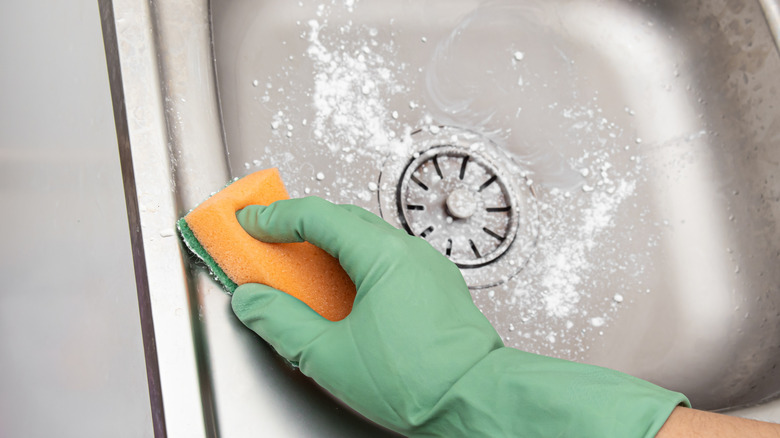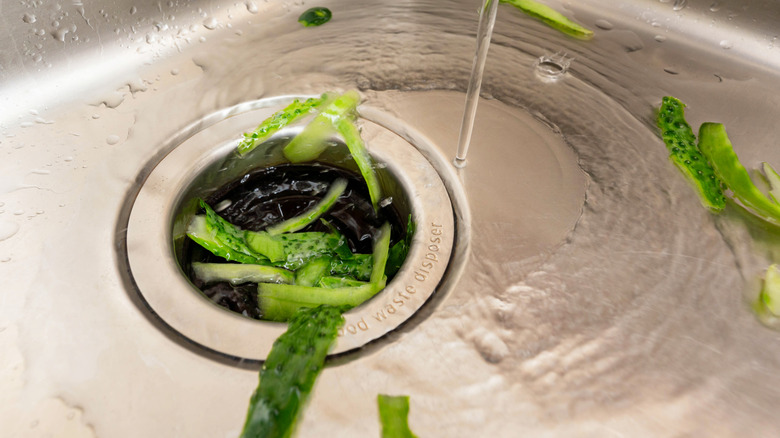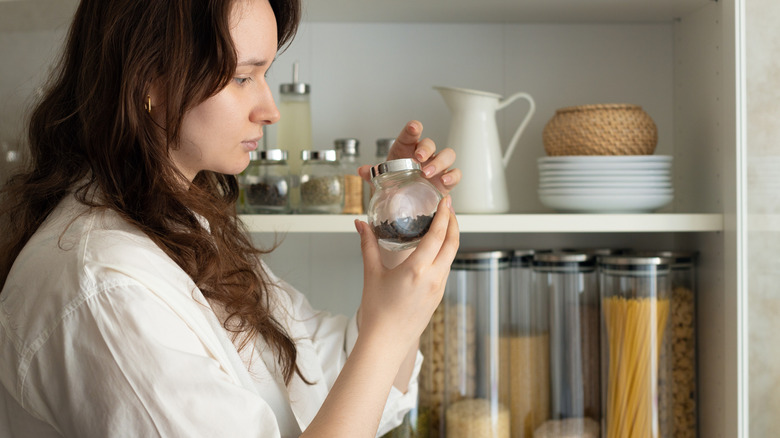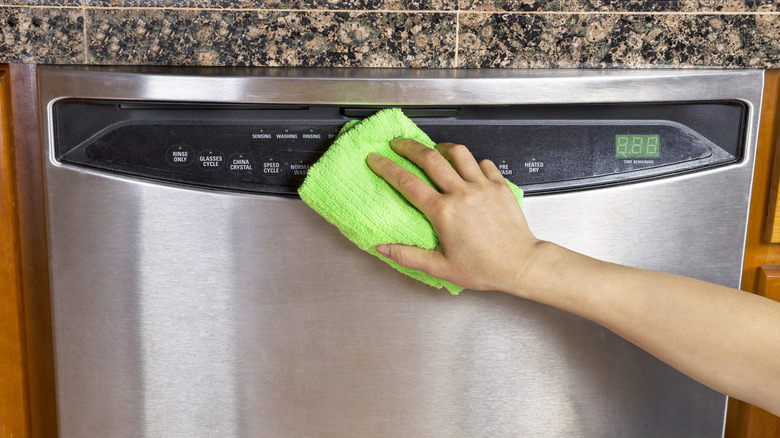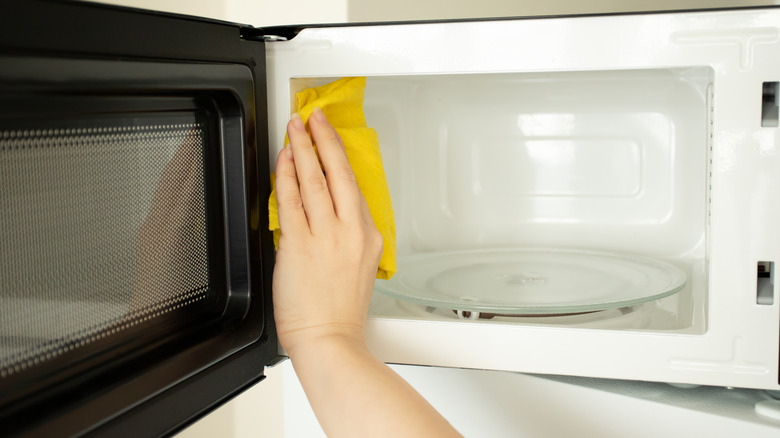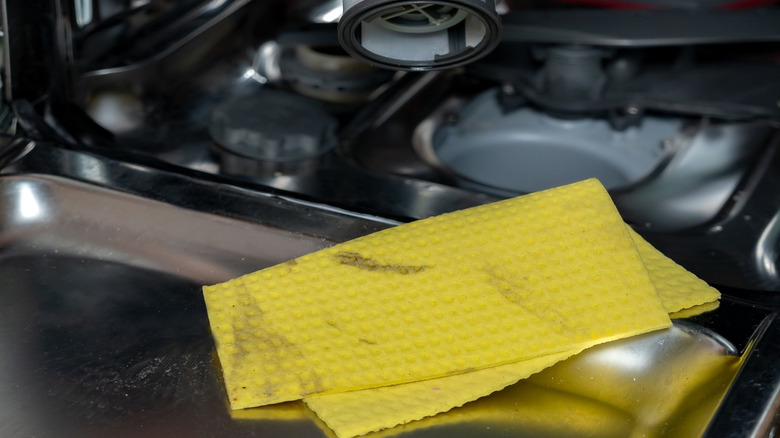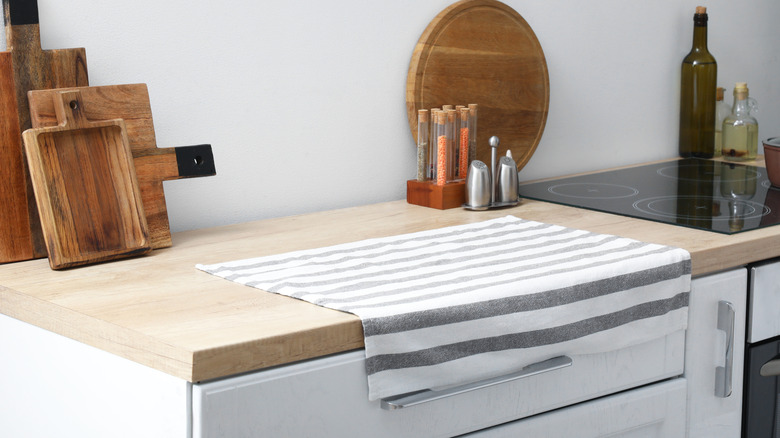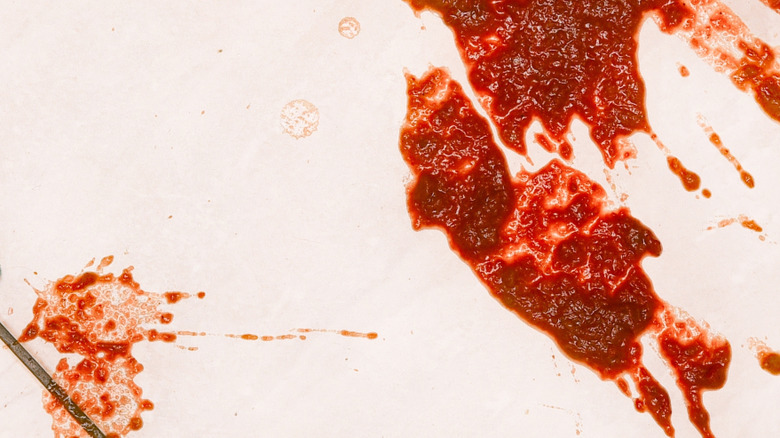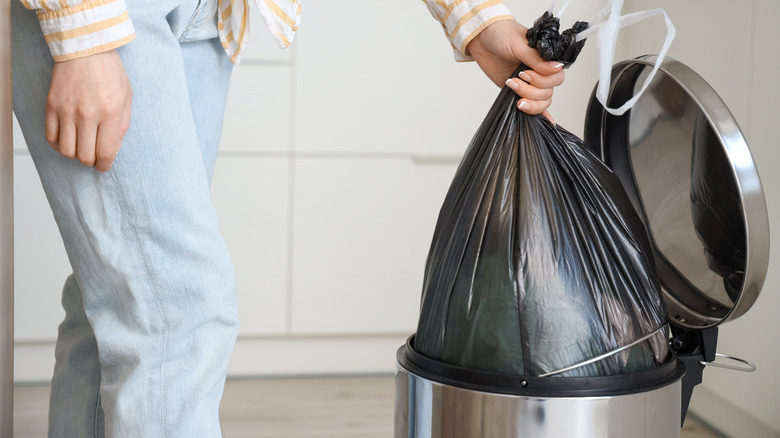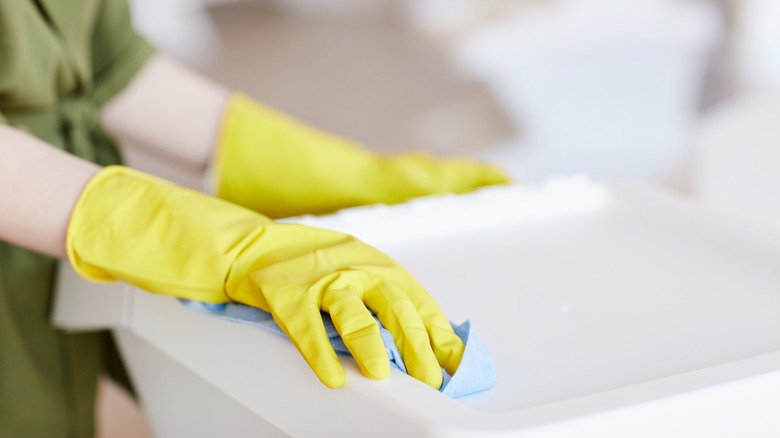19 Weekly Cleaning Habits For A Cleaner Kitchen
It has often been said that the kitchen is the heart of the home. It's where you gather with family and friends, prepare meals for the coming week, and brew your favorite warm beverage each morning. Since it is such an integral space in your home, it makes sense that your kitchen gets pretty messy on any given week. You likely are already doing the bare minimum to keep your kitchen clean — washing dishes, wiping down messes when they happen, running the dishwasher, and rinsing out your coffee pot — but there is a multitude of other weekly tasks that should become a habit if you want a cleaner kitchen.
Whether you realize it or not, your kitchen is harboring all sorts of messes, grime, and bacteria as a result of all the action it sees throughout the week. On a weekly basis, you should prioritize cleaning surfaces like the outside of your appliances, the inside of your sink, and the inside of your microwave. It's also prudent to take things a step further by cleaning lesser-thought-of areas, like organizing the cabinet under the sink, descaling your coffee maker for a fresher-tasting cup of joe, and deodorizing your trash can. For a kitchen that truly shines, you'll also want to scrub away greasy splatters, keep on top of clutter, and wipe out the fridge. Instead of getting overwhelmed by all there is to clean, you can be proactive by cleaning with a purpose.
Clean out the sink
The kitchen sink sees a lot of action over the course of a week, from washing dishes to disposing of leftovers that have potentially gone bad. While you might think that your sink is clean since it gets rinsed regularly, you still need to clean the surface. Studies have found that the kitchen sink can harbor harmful bacteria; thanks to its interaction with raw foods, your sink could be a breeding ground for salmonella, listeria, and more. Lightly clean your sink daily, and weekly, use a disinfecting agent to thoroughly clean it.
Deodorize your sink drain
If you stop after cleaning your kitchen sink, you'll have a cleaner kitchen, but your culinary space might still be stinky; this is because food debris can linger in your drain, causing unpleasant odors. Fortunately, it's easy to tackle this cleaning task by pour in baking soda followed by vinegar, which will help to neutralize odors, as well as clear minor clogs. If you want a fresher result, throw some lemon peel into the garbage disposal side of the sink — it's an easy cleaning hack to tackle your bad-smelling garbage disposal.
Declutter regularly
You might not think that decluttering is a cleaning routine, but it can make a huge difference in the cleanliness of your kitchen. Clutter attracts more clutter and can hinder your ability to properly clean surfaces in your kitchen. If you have papers, gadgets, Tupperware containers, or random odds and ends on your kitchen counters, you should be sorting through them on a regular basis — weekly, if not more often. The same goes for drawers and cabinets in this space. If your kitchen is at its capacity, it will be harder to keep the space clean.
Wipe down counters
Similar to kitchen sinks, kitchen countertops are likely dirtier than you think. Constantly bombarded by falling crumbs, spilled beverages, and sticky condiment bottles, countertops need to be wiped down every day (particularly after meal prep). To keep your kitchen clean, it is also advised that you disinfect countertops once a week using a disinfectant that's safe for the countertop material you have. Finally, just because you can't see anything on your countertops doesn't mean that they are clean — especially if you have darker counters — you might need to get a different angle to fully see that grime.
Wipe out your fridge
Cleaning your fridge regularly is an important part of keeping your kitchen clean. The best way to thoroughly clean this kitchen essential is to remove everything from the shelves and drawers, so you can see what you're working with. Wipe out dry debris like crumbs, followed by a food-safe cleaning product and a washcloth to tackle sticky sauces or spills that are lingering. Now is also a good time to clean debris from the seals around your fridge doors. For the ultimate guide to deep cleaning your fridge, start here.
Throw out old food
Throwing out old food will not only keep your kitchen clean, but it will also help your family stay healthy. Bacteria can grow very quickly in some foods, such as leftovers. If you haven't eaten something within the week (or less for some foods), now's the time to toss it. Of course, some leftovers will go bad much faster than others, depending on a variety of factors, but a weekly roundup is a nice way to keep the contents of your refrigerator fresh and safe to eat.
Clean appliance exteriors
You expect the inside of appliances, like your oven or fridge, to get messy, but it's easy to forget that the outsides need to get cleaned from time to time, too. Sticky fingerprints, splashes of liquid, and daily grime can leave your appliances looking dull and dirty. To ensure your kitchen looks and feels its cleanest, use a microfiber cloth and a multi-surface cleaner to freshen up the outside of all your major appliances, as well as countertop models, like your air fryer. Be sure to avoid spraying the electrical components of countertop tools, like toasters, though.
Clean your coffee maker
If you're like many Americans, you rely heavily on your coffee maker every day. Keeping it clean can ensure that your coffee tastes its best and that your appliance performs well. There are many ways to clean this kitchen appliance — one of the best ways to clean your coffee maker is with plain white vinegar, which will descale any residue that has built up on the machine. You'll also want to wash the carafe itself — do this by hand or throw it in the dishwasher.
Clean the inside of your microwave
The inside of a microwave is often a mess. Hot sauces that have splattered onto the interior and then been baked on can be tricky to remove and look gross, too. Fortunately, you can bust out some diluted white vinegar for the easiest way to clean your microwave. Fill a bowl with water and several tablespoons of vinegar, then microwave it for long enough to let things get steamy — about one or two minutes on high. After letting the steam sit and loosen the debris for about five minutes, wipe it away with a cloth.
Clean your dishwasher filter
Your dishwasher cleans the dishes, so you never have to worry about cleaning your dishwasher, right? Wrong. While your dishwasher does a great job of getting your plates and cups clean, there are certain components in this appliance that need regular TLC to keep it clean and effective. The filter catches larger piece of food from dishes and can get gunked up quickly. Fortunately, these filters are easy to remove in newer models and can be washed with a bit of soap and a washcloth. You'll likely find that your dishwasher works better afterward.
Clean under the sink
The under-the-sink cabinet is often a catch-all space for cleaning supplies, plastic bags, and maybe even a small kitchen trash can. This space can easily get cluttered, however, obstructing your access to valuable storage and also making it difficult to see if anything is going wrong underneath your sink. To keep things simple, it's best to clean this space on a weekly basis, removing the items stored there and wiping it out well. To make your job easier moving forward, consider purchasing a plastic drip tray or storage caddy for the items.
Change dish towels
If you are in the habit of reusing kitchen towels day after day, now is the time to stop. Kitchen towels can harbor a lot of germs since they are used for everything from drying hands to wiping down wet dishes and spills. You should be washing your kitchen towels every day or two to keep things clean and fresh. Fortunately, if you have a good inventory of kitchen towels, you can just swap them for some clean ones while you wash the current load. Check the inventory weekly to make sure you're well-stocked.
Wipe down sneaky splatters
Splatters can be egregious offenders in the kitchen since they can end up anywhere — on the floors, walls, even the ceiling. Of course, it's easiest to wipe spills when they happen, but some food splatters go unnoticed in the moment. A weekly cleaning keeps those stray splatters from building up too much. When you're handling your other weekly cleaning duties, be sure to wipe up any splatter marks that you see. Use a mixture of warm water and dish soap, as well as a rag or cleaning cloth to scrub away any sneaky splatters.
Get new sponges or dish rags
The dirty truth behind your kitchen sponge is that it is pretty nasty. While you might think your trusty scrubbing friend is helping you get your kitchen cleaner, the reality is that it might be spreading germs around unless you are changing it regularly. Once a week, bring a clean sponge into rotation, throwing the old one away. If this feels particularly wasteful to you, it's possible to extend the lifespan of your current sponge a little longer by disinfecting it in the microwave or dishwasher, but those methods could still leave behind germs.
Take out the trash
Emptying the trash can in the kitchen is something that you should be doing on a daily basis if you are a frequent home chef. Veggie and fruit peels, egg shells, and crumbs can stink up your space, as well as attract bugs. If you cook less frequently, it's still a good rule of thumb to take the trash out every couple of days to prevent pests from getting too comfortable in your kitchen. Check on the can weekly to make sure there aren't any pests in it.
Deep clean the trash can
Now that you've emptied the trash, you can take things a step further and deep clean the trash can itself. Use a disinfecting wipe or some diluted rubbing alcohol and paper towels to wipe out the inside of the trash can. This will deodorize your entire space, since trash cans often harbor odors even after they are emptied. This weekly cleaning habit can deodorize and freshen up your entire home, without taking too much time or effort.
Wipe out drawers
It's not rocket science that crumbs accumulate in drawers, but it is an annoying reality of a kitchen that you have to contend with. On a regular basis, it's a good idea to go around and tackle any crumbs that have fallen into the bottom of your utensil drawers. You can remove the contents of the drawer to provide a clear view and easy access to the debris. This task can be super quick if you have a hand vacuum to suck up any messes. Then, wipe the drawers with a wet cloth before returning the contents.
Sweep floors
Sweeping your kitchen floors is one of the most important cleaning tasks you can do. Between meal prep, eating on the go, and simple daily activities, there is probably a lot more debris lingering on the ground than you are aware of. Sweeping (or vacuuming) every single day is the best way to keep your floors clean and ensure that pests aren't attracted to the mess. It will also guarantee that kitchen crumbs aren't shuffled around to other areas of the home. Once a week, check your broom or vacuum to see if it needs to be cleaned.
Mop the floors
A weekly mopping of the kitchen floors is a great way to bring some extra freshness to your home. Mopping removes any of the more stubborn messes or spills that linger throughout the week. Remember that the proper order of cleaning is sweeping first, then mopping second (this prevents simply moving the mess around). Mopping more than once a week is preferable, but you can determine the frequency required for your personal situation based on how busy your kitchen is.

